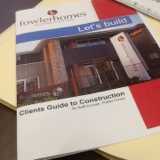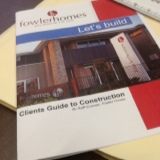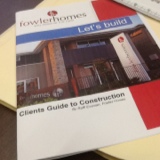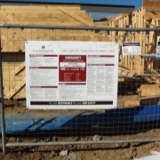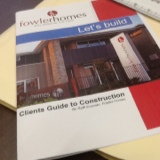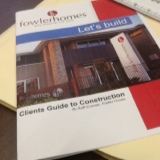General Information
-
Document No.
-
Issued to:
-
Job No./Site Address
-
Conducted on
-
Prepared by
Non Conformance Notice
Non Conformance Information
-
Unsafe Work Practice/Breach of Legal Requirements
Safety Breach
-
Description
- No Risk Assessment
- Incomplete Risk Assessement
- No Current Tag (power)
- No SWMS
- SWMS non compliance
- No Plant Records
- No PPE
- Poor Housekeeping
- Site Security
- No Safety Data Sheet
- Other
-
Work Health and Safety Regulations 2011states:
Part 3.1 Managing risks to health and safety
32 Application of Part 3.1
This Part applies to a person conducting a business or undertaking who has a duty under this Regulation to manage risks to health and safety.
33 Specific requirements must be complied with
Any specific requirements under this Regulation for the management of risk must be complied with when implementing the requirements of this Part.
Examples.
1 A requirement not to exceed an exposure standard.
2 A duty to implement a specific control measure.
3 A duty to assess risk.
34 Duty to identify hazards
A duty holder, in managing risks to health and safety, must identify reasonably foreseeable hazards that could give rise to risks to health and safety.
35 Managing risks to health and safety
A duty holder, in managing risks to health and safety, must:
(a) eliminate risks to health and safety so far as is reasonably practicable, and
(b) if it is not reasonably practicable to eliminate risks to health and safety—minimise those risks so far as is reasonably practicable. -
Work Health & Safety Regulations 2011 states:
299 Safe work method statement required for high risk construction work
(1) A person conducting a business or undertaking that includes the
carrying out of high risk construction work must, before high risk
construction work commences, ensure that a safe work method
statement for the proposed work:
(a) is prepared, or
(b) has already been prepared by another person.
Maximum penalty:
(a) in the case of an individual—$6,000, or
(b) in the case of a body corporate—$30,000.
(2) A safe work method statement must:
(a) identify the work that is high risk construction work, and
(b) specify hazards relating to the high risk construction work and
risks to health and safety associated with those hazards, and
(c) describe the measures to be implemented to control the risks, and
(d) describe how the control measures are to be implemented,
monitored and reviewed.
301 Safe work method statement—copy to be given to principal contractor
A person conducting a business or undertaking that includes carrying
out high risk construction work in connection with a construction
project must, before the high risk construction work commences, ensure
that a copy of the safe work method statement for the work is given to
the principal contractor.
Maximum penalty:
(a) in the case of an individual—$3,600, or
(b) in the case of a body corporate—$18,000.
312 High risk construction work—safe work method statements
The principal contractor for a construction project must take all
reasonable steps to obtain a copy of the safe work method statement
relating to high risk construction work before the high risk construction
work commences.
Maximum penalty:
(a) in the case of an individual—$3,600, or
(b) in the case of a body corporate—$18,000. -
WHS Regulations 2011 states:
300 Compliance with safe work method statement
(1) A person conducting a business or undertaking that includes the carrying out of high risk construction work must put in place arrangements for ensuring that high risk construction work is carried out in accordance with the safe work method statement for the work.
Maximum penalty:
(a) in the case of an individual—$6,000, or
(b) in the case of a body corporate—$30,000.
(2) If high risk construction work is not carried out in accordance with the safe work method statement for the work, the person must ensure that the work:
(a) is stopped immediately or as soon as it is safe to do so, and
(b) resumed only in accordance with the statement.
Maximum penalty:
(a) in the case of an individual—$6,000, or
(b) in the case of a body corporate—$30,000. -
WHS Regulations 2011 states:
237 Records of plant
(1) This clause applies in relation to plant that is required to be registered under Part 5.3.
(2) The person with management or control of the plant at a workplace must keep a record of all tests, inspections, maintenance, commissioning, decommissioning, dismantling and alterations of the plant for the period set out in subclause (3).
Maximum penalty:
(a) in the case of an individual—$1,250, or
(b) in the case of a body corporate—$6,000.
(3) The record must be kept for the period that the plant is used or until the person relinquishes control of the plant.
(4) The person must keep the record available for inspection under the Act.
Maximum penalty:
(a) in the case of an individual—$1,250, or
(b) in the case of a body corporate—$6,000. -
Work Health and Safety Regulation 2011 states:
44 Provision to workers and use of personal protective equipment
(1) This clause applies if personal protective equipment is to be used to minimise a risk to health and safety in relation to work at a workplace in accordance with clause 36.
(2) The person conducting a business or undertaking who directs the carrying out of work must provide the personal protective equipment to workers at the workplace, unless the personal protective equipment has been provided by another person conducting a business or undertaking.
Maximum penalty:
(a) in the case of an individual—$6,000, or
(b) in the case of a body corporate—$30,000.
Example. Equipment that has been provided by a labour hire company.
(3) The person conducting the business or undertaking who directs the carrying out of work must ensure that personal protective equipment provided under subclause (2) is:
(a) selected to minimise risk to health and safety, including by ensuring that the equipment is:
(i) suitable having regard to the nature of the work and any hazard associated with the work, and
(ii) a suitable size and fit and reasonably comfortable for the worker who is to use or wear it, and
(b) maintained, repaired or replaced so that it continues to minimise risk to the worker who uses it, including by ensuring that the equipment is:
(i) clean and hygienic, and
(ii) in good working order, and
(c) used or worn by the worker, so far as is reasonably practicable.
(4) The person conducting a business or undertaking who directs the carrying out of work must provide the worker with information, training and instruction in the:
(a) proper use and wearing of personal protective equipment, and
(b) the storage and maintenance of personal protective equipment.
Maximum penalty:
(a) in the case of an individual—$6,000, or
(b) in the case of a body corporate—$30,000.
Note. A person conducting a business or undertaking must not charge or impose a levy on a worker for the provision of personal protective equipment (see section 273 of the Act). -
Work Health and Safety Regulation 2011
Division 1General
297 Management of risks to health and safety
A person conducting a business or undertaking must manage risks associated with the carrying out of construction work in accordance with Part 3.1.
Note. WHS Act—section 19 (see clause 9). -
298 Security of workplace
(1) A person with management or control of a workplace at which construction work is carried out must ensure, so far as is reasonably practicable, that the workplace is secured from unauthorised access.
Maximum penalty:
(a) in the case of an individual—$3,600, or
(b) in the case of a body corporate—$18,000.
(2) In complying with subclause (1), the person must have regard to all relevant matters, including:
(a) risks to health and safety arising from unauthorised access to the workplace, and
(b) the likelihood of unauthorised access occurring, and
Example. The proximity of the workplace to places frequented by children, including schools, parks and shopping precincts.
(c) to the extent that unauthorised access to the workplace cannot be prevented—how to isolate hazards within the workplace. -
Work Health and Safety Regulation 2011
Division 1General
297 Management of risks to health and safety
A person conducting a business or undertaking must manage risks associated with the carrying out of construction work in accordance with Part 3.1.
Note. WHS Act—section 19 (see clause 9).
298 Security of workplace
(1) A person with management or control of a workplace at which construction work is carried out must ensure, so far as is reasonably practicable, that the workplace is secured from unauthorised access.
Maximum penalty:
(a) in the case of an individual—$3,600, or
(b) in the case of a body corporate—$18,000.
(2) In complying with subclause (1), the person must have regard to all relevant matters, including:
(a) risks to health and safety arising from unauthorised access to the workplace, and
(b) the likelihood of unauthorised access occurring, and
Example. The proximity of the workplace to places frequented by children, including schools, parks and shopping precincts.
(c) to the extent that unauthorised access to the workplace cannot be prevented—how to isolate hazards within the workplace. -
As per AS/NZS 3760 version 2010; all leads and power tools must be tagged every 3 months
-
Other reason to be noted within comments section
-
Comments
-
Photographs
-
Non Compliance to Fowler Homes Site Rules
-
Description
- Fence Couplings missing
- Food Scraps left
- Cuts/dusts not swept
- unauthorised fire
- Damage to dwelling
- Conversation with Clients
- Using Client Toilet
- unauthorised power use
- unauthorised water use
- using client sink
- tools/items on client bench
- marks on ceiling
- other
-
Fowler Homes Contractor Standards States:
At the end of each day, the slab and first floor level should be swept and left free from debris such as saw dust, off cuts and rubbish. Noggings, cavity and bottom plates of frames must be left free of timber shavings.
Leaving debris on the ground will not be tolerated.
It is the responsibility of each contractor to keep the site clean for the next contractor. If the site is left in an untidy manner, this will result in a back charge for additional cleaning. -
Fowler Homes Standards States:
Contractors working on site must not engage in conversation with Clients that are related to contract work. All queries are to be directed to Fowler Homes office. No work is to be carried out on site at the request of the client unless prior acknowledgement from Fowler Homes . -
Fowler Homes Contractor Standards States:
Couplings are not to be removed from fences for access. Fowler Homes Site Manager is to be notified if access is not possible through the gates. If site is left unsecure from previous contractor, Fowler Homes Site Manager must be notified immediately. This should also be addressed through the routine risk assessment to be carried prior to starting work on site. -
Fowler Homes Standard States:
All rubbish and food scraps must be placed in the designated rubbish pile. Unhygienic sites and surroundings will not be tolerated. -
Any contractor found to have caused damage to dwelling must pay costs for rectification of damage. If damage is not reported by contractor, they will also be required to pay costs for issue of this notice. Note: ensure clear photographs are taken of damaged area.
-
Fowler Homes Standard States:
Installed toilet suites must NOT be used. A portable toilet is supplied for the use by all contractors. (finish off stage) -
Unauthorised use of power/water will not be tolerated, if you have been found to be using power/water from neighbouring locations you will be required to pay all costs which may include a fee of compensation for neighbours
-
Fowler Homes Standard States:
Kitchen, vanities and laundry sinks must NOT be used. A portable toilet is supplied on site for the use of contractors. -
Fowler Homes Standard States:
No tools or personal items are to be placed on completed cabinetry such as kitchens and vanities. Any damage to cabinetery will be backcharged automatically to the last contractor on site. -
Fowler Homes Standard States:
All ceilings are to be left free from finger marks and blemishes upon completion of light fittings -
State other reason in comments section
-
Photographs
-
Comments
-
Breach of DA requirements
-
Description
-
Other reason to be noted within comments section
-
Photographs
-
Comments
Immediate Action/Recommendations
-
Change Work Practice
-
Monitor
-
Toolbox talk
-
The completion of a toolbox talk is advised as part of this non conformance report. Ensure a toolbox talk consultation/meeting is undertaken prior to continuing any work for Fowler Homes Pty Ltd. Once complete forward a copy of Toolbox Talk to safety@fowlerhomes.com.au
Corrective Action
-
Is corrective action required as part of this non-conformance?
-
State name of person responsible to carry out corrective action
Charges
-
Is Administration charge of $275 inc GST applicable for issue of this non conformance?
-
A Warning is issued on this occasion
-
Administration charges are considered a debt due and payable to Fowler Homes Pty Ltd. If you would like to contest the issue of this notice or you do not believe information contained within the notice is correct, you may do so in writing to issuing manager.
Sign off
-
Manager authorisation
